
- Homepage
- Composition
- Denomination
- Ae Prutah (34)
- Ae3 (14)
- Antoninianus (104)
- Ar Denarius (42)
- Aurelianianus (12)
- Aureus (145)
- Bi Double Denarius (24)
- Bi Nummus (22)
- Centenionalis (16)
- Cistophorus (24)
- Denarius (1271)
- Double Denarius (63)
- Dupondius (16)
- Nummus (119)
- Prutah (27)
- Quadrigatus (13)
- Sestertius (127)
- Siliqua (15)
- Solidus (169)
- Tetradrachm (21)
- Other (604)
- Era
- Grade
- Ruler
- Antoninus Pius (53)
- Augustus (141)
- Caracalla (53)
- Constantine I (57)
- Constantine Ii (29)
- Domitian (58)
- Gallienus (37)
- Gordian Iii (62)
- Hadrian (100)
- Marcus Aurelius (69)
- Nero (113)
- Nerva (31)
- Philip I (66)
- Septimius Severus (35)
- Severus Alexander (69)
- Theodosius Ii (32)
- Tiberius (69)
- Trajan (97)
- Trajan Decius (28)
- Vespasian (76)
- Other (1607)
- Year
MAXIMINUS II Daia 310AD Silver Argenteus Ancient Roman Coin SOL Rare NGC i64196
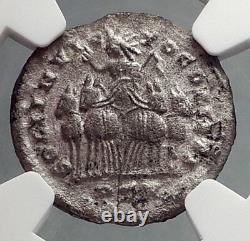
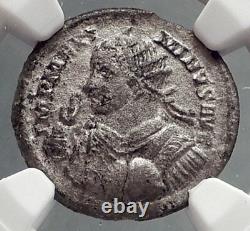
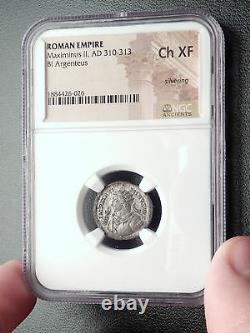
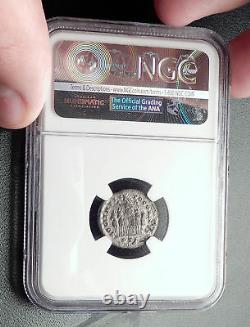
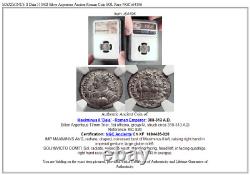


Item: i64196 Authentic Ancient Coin of. Billon Argenteus 17mm Trier, 1st officina, group IV, struck circa 310-313 A. Reference: RIC 826 Certification: NGC Ancients.
Ch XF 1884426-026 IMP MAXIMINVS AVG, radiate, draped, cuirassed bust of Maximinus II left, raising right hand in imperial gesture, large globe in left. SOLI INVICTO COMITI, Sol, radiate, naked to waist, standing facing, head left, in facing quadriga, right hand raised, globe and whip in left; PTR in exergue. Sol was the solar deity in Ancient Roman religion. It was long thought that Rome actually had two different, consecutive sun gods.
The first, Sol Indiges, was thought to have been unimportant, disappearing altogether at an early period. Only in the late Roman Empire, scholars argued, did solar cult re-appear with the arrival in Rome of the Syrian Sol Invictus, perhaps under the influence of the Mithraic mysteries. Recent publications have challenged the notion of two different sun gods in Rome, pointing to the abundant evidence for the continuity of the cult of Sol, and the lack of any clear differentiation - either in name or depiction - between the "early" and "late" Roman sun god. A quadriga (Latin quadri-, four, and iugum, yoke) is a car or chariot drawn by four horses abreast (the Roman Empire's equivalent of Ancient Greek tethrippon). It was raced in the Ancient Olympic Games and other contests. It is represented in profile as the chariot of gods and heroes on Greek vases and in bas-relief. The quadriga was adopted in ancient Roman chariot racing. Quadrigas were emblems of triumph; Victory and Fame often are depicted as the triumphant woman driving it. In classical mythology, the quadriga is the chariot of the gods; Apollo was depicted driving his quadriga across the heavens, delivering daylight and dispersing the night. The word quadriga may refer to the chariot alone, the four horses without it, or the combination.Maximinus II Latin: Gaius Valerius Galerius Maximinus Daia Augustus ; 20 November c. 270 - July or August 313, also known as Maximinus Daia or Maximinus Daza, was Roman Emperor from 308 to 313.
He became embroiled in the Civil wars of the Tetrarchy between rival claimants for control of the empire, in which he was defeated by Licinius. A committed pagan, he engaged in one of the last persecutions of Christians. He was born of Dacian peasant stock to the sister of the emperor Galerius near their family lands around Felix Romuliana, a rural area then in the Danubian region of Moesia, now Eastern Serbia. He rose to high distinction after joining the army. In 305, his maternal uncle Galerius became the eastern Augustus and adopted Maximinus, raising him to the rank of caesar (in effect, the junior eastern Emperor), and granting him the government of Syria and Egypt. In 308, after the elevation of Licinius to Augustus, Maximinus and Constantine were declared filii Augustorum ("sons of the Augusti"), but Maximinus probably started styling himself after Augustus during a campaign against the Sassanids in 310. On the death of Galerius in 311, Maximinus divided the Eastern Empire between Licinius and himself. When Licinius and Constantine began to make common cause, Maximinus entered into a secret alliance with the usurper Caesar Maxentius, who controlled Italy.He came to an open rupture with Licinius in 313; he summoned an army of 70,000 men but sustained a crushing defeat at the Battle of Tzirallum in the neighbourhood of Heraclea Perinthus on April 30. He fled, first to Nicomedia and afterwards to Tarsus, where he died the following August. His death was variously ascribed "to despair, to poison, and to the divine justice".
Maximinus has a bad name in Christian annals for renewing their persecution after the publication of the Edict of Toleration by Galerius, acting in response to the demands of various urban authorities asking to expel Christians. In one rescript replying to a petition made by the inhabitants of Tyre, transcribed by Eusebius of Caesarea, Maximinus expounds an unusual pagan orthodoxy, explaining that it is through "the kindly care of the gods" that one could hope for good crops, health, and the peaceful sea, and that not being the case, one should blame "the destructive error of the empty vanity of those impious men [that] weighed down the whole world with shame".In one extant inscription CIL III. 12132, from Arycanda from the cities of Lycia and Pamphylia asking for the interdiction of the Christians, Maximinus replied, in another inscription, by expressing his hope that may those... Who, after being freed from... Rejoice [as] snatched from a grave illness.
After the victory of Constantine over Maxentius, however, Maximinus wrote to the Praetorian Prefect Sabinus that it was better to "recall our provincials to the worship of the gods rather by exhortations and flatteries". Eventually, on the eve of his clash with Licinius, he accepted Galerius' edict; after being defeated by Licinius, shortly before his death at Tarsus, he issued an edict of tolerance on his own, granting Christians the rights of assembling, of building churches, and the restoration of their confiscated properties.
The Christian writer Eusebius claims that Maximinus was consumed by avarice and superstition. He also allegedly lived a highly dissolute lifestyle.And he went to such an excess of folly and drunkenness that his mind was deranged and crazed in his carousals; and he gave commands when intoxicated of which he repented afterward when sober. He suffered no one to surpass him in debauchery and profligacy, but made himself an instructor in wickedness to those about him, both rulers and subjects. He urged on the army to live wantonly in every kind of revelry and intemperance, and encouraged the governors and generals to abuse their subjects with rapacity and covetousness, almost as if they were rulers with him. Why need we relate the licentious, shameless deeds of the man, or enumerate the multitude with whom he committed adultery?
For he could not pass through a city without continually corrupting women and ravishing virgins. According to Eusebius, only Christians resisted him. For the men endured fire and sword and crucifixion and wild beasts and the depths of the sea, and cutting off of limbs, and burnings, and pricking and digging out of eyes, and mutilations of the entire body, and besides these, hunger and mines and bonds.In all they showed patience in behalf of religion rather than transfer to idols the reverence due to God. And the women were not less manly than the men in behalf of the teaching of the Divine Word, as they endured conflicts with the men, and bore away equal prizes of virtue. And when they were dragged away for corrupt purposes, they surrendered their lives to death rather than their bodies to impurity.
He refers to one high-born Christian woman who rejected his advances. He exiled her and seized all of her wealth and assets.
Eusebius does not give the girl a name, but Tyrannius Rufinus calls her "Dorothea, " and writes that she fled to Arabia. This story may have evolved into the legend of Dorothea of Alexandria. Caesar Baronius identified the girl in Eusebius' account with Catherine of Alexandria, but the Bollandists rejected this theory. Civil Wars of the Tetrarchy (306-324 AD). World-renowned expert numismatist, enthusiast, author and dealer in authentic ancient Greek, ancient Roman, ancient Byzantine, world coins & more.
Ilya Zlobin is an independent individual who has a passion for coin collecting, research and understanding the importance of the historical context and significance all coins and objects represent. Send me a message about this and I can update your invoice should you want this method.
Getting your order to you, quickly and securely is a top priority and is taken seriously here. Great care is taken in packaging and mailing every item securely and quickly. What is a certificate of authenticity and what guarantees do you give that the item is authentic? You will be very happy with what you get with the COA; a professional presentation of the coin, with all of the relevant information and a picture of the coin you saw in the listing. Additionally, the coin is inside it's own protective coin flip (holder), with a 2x2 inch description of the coin matching the individual number on the COA. Whether your goal is to collect or give the item as a gift, coins presented like this could be more prized and valued higher than items that were not given such care and attention to. When should I leave feedback? Please don't leave any negative feedbacks, as it happens sometimes that people rush to leave feedback before letting sufficient time for their order to arrive. The matter of fact is that any issues can be resolved, as reputation is most important to me. My goal is to provide superior products and quality of service. How and where do I learn more about collecting ancient coins? Visit the Guide on How to Use My Store. For on an overview about using my store, with additional information and links to all other parts of my store which may include educational information on topics you are looking for. This item is in the category "Coins & Paper Money\Coins: Ancient\Roman: Imperial (27 BC-476 AD)". The seller is "highrating_lowprice" and is located in this country: US. This item can be shipped worldwide.- Ruler: Maximinus II Daia
- Ancient Coins: Roman Coins
- Coin Type: Ancient Roman
- Composition: Silver
- Certification: NGC
- Material: Silver
- Denomination: Denomination_in_description
- Year: Year_in_description

